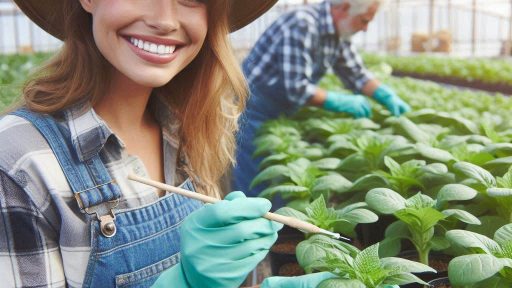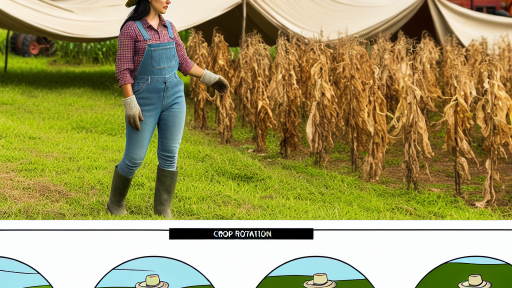Introduction
Crop cultivation is essential for high yields in farming as it ensures a steady food supply.
However, farmers often encounter challenges such as pests, disease, and adverse weather conditions.
Choosing the Right Crop
Select crops that are suitable for your climate and soil type to maximize yield potential.
Conduct thorough research and seek advice from agricultural experts.
Soil Preparation
Ensure proper soil health by conducting soil tests and adding necessary nutrients.
Properly till the land to ensure optimum aeration and water infiltration.
Seed Selection
Choose high-quality seeds from reputable sources to ensure good germination rates and healthy plant growth.
Consider factors like resistance to pests and diseases.
Optimal Planting
Plant seeds at the right depth and spacing to avoid overcrowding and competition for nutrients.
Follow recommended planting schedules for each crop.
Irrigation
Provide adequate water for the crops, especially during dry periods.
Utilize efficient irrigation systems to ensure even distribution and minimize water wastage.
Weed Control
Regularly monitor the field for weed growth and implement effective weed control measures.
Mulching and hand weeding can help reduce competition for nutrients.
Pest and Disease Management
Implement integrated pest management practices to control pests and diseases.
Use natural predators, crop rotation, and resistant varieties to minimize chemical use.
Fertilization
Apply fertilizers in the right amounts and at the right time to support plant growth.
Avoid over-fertilization, as it can lead to nutrient runoff and environmental issues.
Monitoring and Maintenance
Regularly inspect the crops for any signs of stress, disease, or nutrient deficiencies.
Take corrective measures promptly to ensure healthy plant growth and high yields.
Harvesting
Harvest crops at the right maturity stage to ensure quality and maximize yield.
Use proper harvesting techniques to minimize damage to the plants and improve storage life.
Selecting the Right Seeds
When it comes to cultivating crops for high yields, selecting the right seeds is crucial for success.
High-quality seeds are the foundation for a bountiful harvest, so it’s essential to choose wisely.
Here are some key points to consider when selecting seeds:
Importance of High-Quality Seeds
High-quality seeds are genetically superior and have been bred to produce strong, healthy plants with high yields.
Investing in good seeds can make a significant difference in the overall outcome of your crop cultivation.
Tips for Selecting Seeds
Here are some important factors to consider when choosing seeds:
1. Climate
Take into account the climate of your region when selecting seeds.
Some crops thrive in specific temperature ranges and growing conditions, so it’s essential to choose seeds that are well-suited to your local climate.
Transform Your Agribusiness
Unlock your farm's potential with expert advice tailored to your needs. Get actionable steps that drive real results.
Get Started2. Soil Type
Consider the type of soil you have in your field or garden.
Different crops require different soil types to grow successfully, so make sure to choose seeds that are compatible with the soil conditions in your area.
3. Crop Type
Each type of crop has different requirements for optimal growth.
When selecting seeds, consider the specific needs of the crop you are planning to cultivate.
Some crops may require more sunlight, water, or nutrients than others, so it’s important to choose seeds that align with the requirements of the crop you want to grow.
By carefully considering these factors and selecting high-quality seeds that are well-suited to your local climate, soil type, and crop type, you can set yourself up for success in crop cultivation.
Remember, the foundation of a successful harvest starts with choosing the right seeds.
Soil Preparation
Proper soil preparation is essential for achieving high yields in crop cultivation.
It sets the foundation for successful growth and abundant harvests by providing the plants with the essential nutrients and conditions they need to thrive.
The significance of proper soil preparation before planting crops can be summarized in the following points:
- Soil Testing: Before planting, it is crucial to conduct soil testing to determine the current nutrient levels and pH balance of the soil.
This information helps in making informed decisions about the types and amounts of fertilizers needed for optimal growth. - Nutrient Management: Based on the results of soil testing, farmers can develop a nutrient management plan to address any deficiencies in the soil.
This plan may involve the application of fertilizers, organic matter, or other soil amendments to ensure that the crops have access to the necessary nutrients for healthy growth. - Soil Conditioning Techniques: To improve soil structure and fertility, various soil conditioning techniques can be employed.
This includes practices such as tilling, mulching, composting, and cover cropping, which help to enhance water retention, aeration, and nutrient availability in the soil.
By focusing on soil preparation and ensuring that the soil is in optimal condition before planting, farmers can boost crop yields and quality, leading to more productive harvests and greater profitability.
Investing time and effort into preparing the soil can pay off significantly in the long run, making it a critical step in successful crop cultivation.
Crop Rotation
Crop rotation is a crucial practice in agriculture that involves growing different types of crops in the same area over different seasons.
This method plays a significant role in maintaining soil fertility and reducing pests, ultimately leading to higher crop yields.
Benefits of Crop Rotation
- Soil Fertility: Crop rotation helps in replenishing soil nutrients by alternating crops with different nutrient requirements.
It prevents depletion of specific nutrients and promotes overall soil health. - Pest and Disease Management: By rotating crops, farmers disrupt the life cycles of pests and diseases that target specific crops.
This reduces the build-up of pests in the soil, decreasing the need for chemical pesticides. - Weed Control: Crop rotation can help in managing weed growth as different crops may require varying methods of weed control.
It can also break the cycle of weed infestation by altering cultivation practices. - Improved Soil Structure: Diverse crop rotations can enhance soil structure by promoting the growth of different root systems.
This minimizes soil compaction and erosion, resulting in better water and nutrient infiltration.
Different Crop Rotation Methods
- Legume Rotation: Legumes such as peas and beans are known for fixing nitrogen in the soil.
Rotating legumes with other crops can increase soil nitrogen levels, benefiting subsequent crops. - Grass-Legume Rotation: Combining grass and legume crops in rotation can improve soil fertility, weed suppression, and overall soil health.
Grasses help in breaking pest and disease cycles of legumes. - Cash Crop Rotation: Rotating cash crops with cover crops or green manure crops can enhance soil fertility and reduce erosion.
It can also improve crop quality and increase yields over time. - Crop Sequence Rotation: Planning a sequence of crops based on their nutrient requirements and growth habits can optimize soil health and crop productivity.
This method involves strategic planning and monitoring of crop rotations. - Perennial Rotation: Introducing perennial crops into rotation can provide long-term benefits such as increased biodiversity, carbon sequestration, and reduced soil erosion.
Perennials help in soil regeneration and sustainable land use.
Impact on Crop Cultivation
- Increased Yields: Proper crop rotation can lead to increased crop yields over time due to improved soil fertility and pest management.
Healthy soils produce healthier crops with better quality and quantity. - Sustainable Practices: Crop rotation promotes sustainable agriculture by reducing reliance on chemical inputs and improving overall soil health.
It builds resilience in cropping systems and reduces environmental impacts. - Risk Mitigation: Rotating crops reduces the risk of crop failures due to pest outbreaks, diseases, or adverse weather conditions.
Diversifying crops in rotation spreads out risks and ensures better farm resilience. - Long-Term Soil Health: By maintaining soil fertility and structure, crop rotation supports long-term soil health and productivity.
It reduces the need for expensive soil amendments and preserves natural resources for future generations.
Basically, crop rotation is a valuable practice that benefits both farmers and the environment.
By implementing diverse crop rotations and understanding their impact on crop cultivation, farmers can achieve high yields sustainably while preserving soil fertility for future generations.
Read: Mastering Palm Kernel Farming: A Complete Process Guide
Pest and Disease Control
Managing pests and diseases is essential for successful crop cultivation.
Without proper control measures, these factors can significantly reduce yields and quality of produce.
Here are some key points to consider when developing pest and disease management strategies:
Importance of Pest and Disease Management
- Prevents crop damage
- Minimizes yield losses
- Ensures quality produce
- Reduces reliance on chemical pesticides
Identifying common pests and diseases is crucial for effective control.
Here are some tips on how to recognize signs of infestation:
Identifying Common Pests and Diseases
- Leaf discoloration
- Chewed or holes in leaves
- Powdery mildew on plants
- Stunted growth or wilting
Once pests and diseases are identified, it’s important to implement control methods.
Organic approaches are preferred to minimize chemical exposure and promote environmental sustainability.
Here are some organic control methods to consider:
Organic Control Methods
- Introduce beneficial insects
- Use companion planting to deter pests
- Apply neem oil as a natural pesticide
- Utilize homemade garlic spray for pests
Remember to monitor your crops regularly for any signs of pests or diseases.
Early detection and action can prevent widespread infestations and ensure a bountiful harvest.
Read: Crop-Specific Tech: Precision Cultivation Tips
Irrigation and Water Management
Proper irrigation and water management play a crucial role in ensuring high crop yields.
Here are some key points to consider:
- Choose the right irrigation system: Selecting the appropriate irrigation system based on the crop type, soil type, and climate conditions is essential for maximizing water efficiency.
- Drip irrigation: Drip irrigation is one of the most efficient water conservation techniques.
It delivers water directly to the roots of the plants, minimizing water wastage. - Sprinkler irrigation: Sprinkler irrigation is suitable for crops that require overhead watering.
It is important to ensure proper spacing and coverage to avoid water runoff. - Furrow irrigation: Furrow irrigation is commonly used for row crops.
Proper land leveling is crucial to ensure uniform water distribution along the furrows.
Water conservation techniques
- Mulching: Mulching helps retain soil moisture by reducing evaporation.
Organic mulches also provide nutrients to the soil as they decompose. - Cover cropping: Planting cover crops during off-seasons can help improve soil structure and water retention, reducing the need for irrigation.
- Rainwater harvesting: Implementing rainwater harvesting systems can help capture and store rainwater for irrigation purposes, reducing reliance on groundwater sources.
Scheduling irrigation
- Monitor soil moisture: Regularly check the soil moisture levels to determine the optimal timing for irrigation.
Avoid overwatering or underwatering the crops. - Early morning or late evening watering: Watering during the early morning or late evening hours reduces water loss due to evaporation, ensuring maximum water absorption by the plants.
- Use weather data: Utilize weather forecast information to adjust irrigation schedules based on upcoming rainfall or temperature conditions to avoid water wastage.
By implementing efficient irrigation systems, water conservation techniques, and proper scheduling of irrigation, farmers can effectively manage water resources and optimize crop yields.
Read: Tomato Harvesting: Techniques for Quality

Weed Management
Weeds are a common problem in crop cultivation, posing a significant threat to both crop yields and quality.
They compete with crops for essential resources such as water, nutrients, and sunlight.
Weeds can also serve as hosts for pests and diseases, further affecting the overall health of the crop.
Negative Impact of Weeds
- Reduction in crop yields
- Degradation of crop quality
- Increased competition for resources
- Interference with crop growth and development
To prevent these negative effects, effective weed management strategies must be implemented throughout the crop cultivation process.
Strategies for Effective Weed Control
1. Manual Methods
Manual weed control involves physically removing weeds from the field.
This method is labor-intensive but can be highly effective, especially in small-scale farming operations.
Some common manual weed control techniques include hand-weeding, hoeing, and pulling weeds by hand.
It is essential to remove weeds before they mature and produce seeds to prevent further infestations.
2. Chemical Methods
Chemical weed control involves the use of herbicides to kill or suppress weeds.
Herbicides are available in various formulations, including pre-emergent and post-emergent products.
It is crucial to select the right herbicide based on the type of weeds present, the crop being grown, and environmental considerations.
Application timing and proper dosage are key factors in successful chemical weed control.
It is essential to follow label instructions and safety precautions when using herbicides to avoid harming the crop or the environment.
3. Crop Rotation
Crop rotation is an effective cultural practice that can help reduce weed pressure in the field.
By rotating crops with different growth habits and root structures, farmers can disrupt weed growth cycles and prevent the buildup of weed populations.
Certain crops, such as legumes, can also help naturally suppress weeds by releasing chemicals that inhibit weed growth.
4. Mulching
Applying mulch to the soil surface can help prevent weed growth by blocking sunlight and reducing weed seed germination.
Mulching also helps retain soil moisture, regulate soil temperature, and improve soil health.
Organic mulches, such as straw, leaves, and grass clippings, can decompose over time and add valuable nutrients to the soil.
Inorganic mulches, such as plastic or landscape fabric, provide long-lasting weed control but may require additional maintenance.
5. Integrated Weed Management
Integrated Weed Management (IWM) combines multiple weed control strategies to create a comprehensive and sustainable approach to weed management.
By using a combination of cultural, mechanical, biological, and chemical control methods, farmers can effectively control weeds while minimizing the negative impacts on the environment and human health.
IWM strategies should be tailored to specific crop types, weed species, and growing conditions to achieve the best results.
Showcase Your Farming Business
Publish your professional farming services profile on our blog for a one-time fee of $200 and reach a dedicated audience of farmers and agribusiness owners.
Publish Your ProfileIn fact, effective weed management is crucial for achieving high yields and quality in crop cultivation.
By implementing a combination of manual, chemical, cultural, and integrated weed control strategies, farmers can effectively manage weed infestations and ensure the success of their crops.
Read: Chemical Fertilizers: Understanding Risks
Fertilizer Application
One of the key factors in achieving high yields in crop cultivation is proper fertilizer application.
Balanced fertilization is essential for optimal crop growth and development.
Importance of Balanced Fertilizer Application
- Provides essential nutrients: Fertilizers supply crops with necessary nutrients like nitrogen, phosphorus, and potassium for healthy growth.
- Promotes strong root development: Proper fertilization helps in the development of robust root systems, allowing plants to access water and nutrients efficiently.
- Improves crop resistance: Well-fed plants are more resilient to pests, diseases, and adverse environmental conditions due to improved overall health.
- Increases yield potential: Adequate fertilization can significantly boost crop yields by ensuring plants have all the nutrients needed for optimal productivity.
Choosing the Right Type of Fertilizers
- Soil testing: Conduct soil tests to determine nutrient deficiencies and pH levels, which can guide you in selecting the appropriate fertilizers.
- Crop requirements: Different crops have varying nutrient needs at different growth stages, so choose fertilizers that cater to your specific crop requirements.
- Slow-release vs. quick-release fertilizers: Consider using a combination of slow-release and quick-release fertilizers for sustained nutrient availability throughout the growing season.
- Organic vs. inorganic fertilizers: Decide whether to use organic or inorganic fertilizers based on factors like cost, nutrient content, and environmental impact.
Amount of Fertilizers to Apply
- Follow recommended rates: Consult with agricultural experts or refer to extension resources to determine the appropriate amount of fertilizers to apply per crop.
- Consider growth stage: Adjust fertilizer application rates based on the crop’s growth stage to meet changing nutrient demands during different phases of development.
- Monitor plant response: Regularly observe crop growth and appearance to assess if additional fertilization is needed to address any deficiencies or excesses.
- Avoid overfertilization: Excessive fertilizer application can lead to nutrient imbalances, soil degradation, environmental pollution, and reduced crop quality.
By understanding the significance of balanced fertilizer application, choosing the right type and amount of fertilizers, and implementing proper fertilization practices, you can enhance your crop cultivation efforts and achieve high yields.
Harvesting and Post-Harvest Practices
Proper harvesting techniques and post-harvest practices are crucial for maximizing crop yields.
By following these tips, you can ensure that your hard work pays off and your produce maintains its quality.
Significance of Proper Harvesting Techniques
- Harvesting at the right time ensures optimal yield and quality.
- Improper harvesting can result in underdeveloped or overripe crops.
- Proper techniques help minimize damage to the plants and ensure sustainability.
Tips on Harvesting at the Right Time
- Observe the crop closely for signs of maturity, such as color changes or size.
- Harvest in the early morning when the plants are hydrated and temperatures are cooler.
- Use sharp tools to cut the produce to prevent bruising and damage.
Handling Crops Carefully
- Avoid dropping or throwing the harvested crops to prevent bruising.
- Handle with care to avoid damaging the skin or flesh of the produce.
- Use proper containers or bins to transport the crops without causing harm.
Storing Produce to Maintain Quality
- Store fruits and vegetables in a cool, dark place to slow down ripening.
- Avoid storing produce near ethylene-producing fruits like bananas, as they can promote ripening.
- Consider the shelf life of each crop and consume or preserve accordingly.
By practicing proper harvesting techniques and post-harvest practices, you can ensure that your crop cultivation efforts result in high yields and quality produce.
Remember to handle your crops with care and store them correctly to enjoy the fruits of your labor for a longer time.
Conclusion
In this blog, we explored the secrets to perfect crop cultivation for high yields.
Here’s a summary of key points:
- Soil Health: Maintain soil fertility with proper nutrients and organic matter.
Healthy soil boosts crop growth and yields. - Water Management: Use efficient irrigation systems. Ensure consistent watering to optimize plant health and productivity.
- Crop Selection: Choose high-yielding crop varieties suited to your local climate.
This choice directly impacts overall yield. - Pest Control: Implement integrated pest management strategies.
Prevent pests from damaging crops and reducing yields. - Fertilization: Apply balanced fertilizers based on soil tests.
This practice enhances plant growth and crop yields. - Plant Spacing: Space plants appropriately to allow for optimal growth.
Avoid overcrowding to ensure each plant gets adequate resources. - Monitoring and Adjustments: Regularly monitor crop health and adjust practices as needed.
Stay proactive in addressing any issues.
Farmers should implement these strategies in their farming practices.
Following these tips will lead to successful crop cultivation and improved yields.
Embrace these techniques, and watch your productivity and profitability soar.




